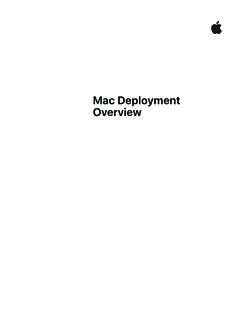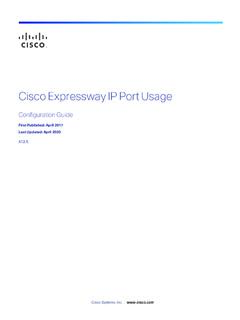Transcription of Azure MFA Integration with NetScaler - Citrix Virtual Apps
1 GuideDeployment GuideAzure MFA Integration with NetScaler This guide focuses on describing the configuration required for integrating Azure MFA (Multi-Factor Authentication) with NetScaler . | Deployment Guide | Azure MFA Integration with NetScaler ( ldap )Deployment GuideAzure MFA Integration with NetScaler ( ldap ) NetScaler is a world-class application delivery controller (ADC) with the proven ability to load balance, accelerate, optimize and secure enterprise applications. Azure Multi-Factor Authentication (MFA) is Microsoft's two-step verification solution. It delivers authentication through multiple verification methods, including phone call, text message, or mobile app verification. By integrating with NetScaler , the time required for configuring Azure MFA as part of an enterprise authentication solution is significantly reduced by configuring Azure MFA as an authentication factor for NetScaler .This deployment guide focuses on integrating Microsoft Azure Multi Factor Authentication (MFA) with NetScaler .
2 This Integration will allow use of the Azure MFA server as one of the authentication factors on NetScaler . This will allow users to use NetScaler for all authentication while being able to utilize Azure 's multi factor authentica-tion capabilities,. NetScaler is a world-class application delivery controller (ADC) with the proven ability to load balance, acceler-ate, optimize and secure enterprise applications. Azure Multi-Factor Authentication seamlessly integrates with NetScaler to provide additional security for logins and portal access. Multi-factor authentication (MFA) is combined with standard user credentials to increase security for user identity verification. NetScaler also supports similar capabilties as Azure MFA; this enables enterprise users to choose how they want their authentication landscape to be this guide, we will be looking at ldap based Integration for Azure MFA. NOTE: Parts of this document use configuration information from # | Deployment Guide | Azure MFA Integration with NetScaler ( ldap )Deployment GuideAzure MFA Integration with NetScaler ( ldap )The following software versions are used and recommended for this configuration - SoftwareVersionNetScaler VPX (Enterprise/Platinum) MFA DetailsThe test deployment topology is shown in Figure 1.
3 This features an authentication setup with one NetScaler appliance, one Azure MFA server and a a backend Active Directory/ ldap server for 1: Deployment | Deployment Guide | Azure MFA Integration with NetScaler ( ldap )Deployment GuideAzure MFA Integration with NetScaler ( ldap )Part 1: Configure Azure MFA ServerThe following configuration is for the Azure MFA Server. 1. Configure ldap Authentication on the Azure MFA Server. 2. Connect Azure MFA to the directory service (Active Directory), then configure a default authentication method. 3. Import accounts to the MFA Users Azure MFA authentication1. Connect and log in to the Windows server where Azure MFA is Open the apps screen. (Windows Server 2012)3. Click the Multi-Factor Authentication Server icon under Multi-Factor Authentication Server (shown below) 4. The Multi-Factor Authentication Server window will open as shown | Deployment Guide | Azure MFA Integration with NetScaler ( ldap )Deployment GuideAzure MFA Integration with NetScaler ( ldap )1.
4 Now, enable ldap authentication and add NetScaler as a client. Click the ldap authentication icon in the left hand side panel as shown below -2. When the ldap Authentication section is opened, select Enable ldap | Deployment Guide | Azure MFA Integration with NetScaler ( ldap )Deployment GuideAzure MFA Integration with NetScaler ( ldap )1. Select the Clients tab and change the port number, if necessary. The default ports are 389 for plaintext and 636 for SSL encryption. 2. if secure ldap (LDAPS) is in use, click Browse and add the SSL | Deployment Guide | Azure MFA Integration with NetScaler ( ldap )Deployment GuideAzure MFA Integration with NetScaler ( ldap )1. Click Add in the last dialog box shown to add a new ldap the following details here:IP address enter the NetScaler SNIP that will be used to communicate with Azure MFAA pplication name enter a descriptive name for the NetScaler client connectionRequire Multi-Factor Authentication user match If selected, only users who are included in the MFA Users list will be granted access; otherwise, only users who are included in the MFA Users list will need to authenticate with MFA.
5 Other domain users will be able to authenticate without MFA. 2. Select the Target tab and verify that it shows ldap . This completes the adding of NetScaler as an ldap cli-ent and enabling of ldap authentication. | Deployment Guide | Azure MFA Integration with NetScaler ( ldap )Deployment GuideAzure MFA Integration with NetScaler ( ldap )Directory Integration1. On the Multi-Factor Authentication Server window, click on Directory Integration in the navigation When the Directory Integration tool opens, select the Settings | Deployment Guide | Azure MFA Integration with NetScaler ( ldap )Deployment GuideAzure MFA Integration with NetScaler ( ldap )1. Select Use Specific ldap Click Edit to open the Edit ldap Configuration dialog | Deployment Guide | Azure MFA Integration with NetScaler ( ldap )Deployment GuideAzure MFA Integration with NetScaler ( ldap )1. Enter the following settings: Server enter the directory server host name or IP address. NOTE: An FQDN is required if the Bind type below is set to SSL.
6 Base DN enter the directory path. Bind type select the protocol to use for directory searches and authentication. NOTE: assigning the correct bind type is essential for security. Queries search options are: Anonymous Simple SSL Windows Authentication authentication options are: Anonymous Simple SSL Windows Bind DN only required for the SSL Bind type; enter a domain\user account with administrator privileges. Bind Password only required for the SSL Bind type; enter the password for the account. Query size limit specify the maximum number of users a search will click to confirm that the 2. MFA server is able to successfully connect to the ldap Once the test completes successfully, click Click OK to close the completion prompt. This completes MFA server directory service Authentication MethodThe Default Authentication Method defines the default authentication method that will be automatically as-signed to MFA users; this method is required when users are not allowed to change authentication methods to ensure that there is a base authentication option assigned to every user.
7 This is optional when users are allowed to change authentication | Deployment Guide | Azure MFA Integration with NetScaler ( ldap )Deployment GuideAzure MFA Integration with NetScaler ( ldap )1. Next, configure Company Settings. Click on Company Settings in the Navigation area:2. Select the General | Deployment Guide | Azure MFA Integration with NetScaler ( ldap )Deployment GuideAzure MFA Integration with NetScaler ( ldap )1. Leave default settings except for the following: User defaults select one of the options below: Phone call select Standard from the dropdown menu. Text message select Two-Way and OTP from the dropdown | Deployment Guide | Azure MFA Integration with NetScaler ( ldap )Deployment GuideAzure MFA Integration with NetScaler ( ldap ) Mobile app select Standard from the drop menu:(this option requires device registration through the Azure Authentication app)This completes the configuration for the Company Information Section for ldap , as the NetScaler is configured as an ldap client, access is restricted to the vserver to only MFA users.
8 To avoid the need for ldap requests to require MFA, the administrator account has to the configured, and user ac-counts must be imported from the ldap of User Accounts1. Click the Users icon in the navigation section as shown below | Deployment Guide | Azure MFA Integration with NetScaler ( ldap )Deployment GuideAzure MFA Integration with NetScaler ( ldap )1. In the Users section, Click Import from Select a user group on the Import screen | Deployment Guide | Azure MFA Integration with NetScaler ( ldap )Deployment GuideAzure MFA Integration with NetScaler ( ldap )1. Select the user accounts you want to import. Leave the settings as is, in this deployment flow the Import Phone option is set to Mobile. (Other options are also available)2. Click the Import button. Then, click OK in the Import Success dialog box. Click Close on the Import screen to go back to the Users | Deployment Guide | Azure MFA Integration with NetScaler ( ldap )Deployment GuideAzure MFA Integration with NetScaler ( ldap )Configuring the MFA Administrator AccountNow, configure the MFA administrator account to allow ldap requests without requiring MFA Select the Administrator account in the Users Click Select the General | Deployment Guide | Azure MFA Integration with NetScaler ( ldap )Deployment GuideAzure MFA Integration with NetScaler ( ldap )1.
9 Clear the Enabled Select the Advanced | Deployment Guide | Azure MFA Integration with NetScaler ( ldap )Deployment GuideAzure MFA Integration with NetScaler ( ldap )1. Leave the default settings, except for the following: When user is disabled select Succeed Authentication. Account is used for ldap Authentication password changes this will allow end users to change their own Click Apply, then click completes configuration of the MFA | Deployment Guide | Azure MFA Integration with NetScaler ( ldap )Deployment GuideAzure MFA Integration with NetScaler ( ldap )Part 2: Configure the NetScaler ApplianceThe following configuration is required on the NetScaler appliance: ldap authentication policy and server for domain authentication SSL certificate with external and internal DNS configured for the FQDN presented by the certificate (Wild-card certificates are supported.) VPN Virtual serverThis guide covers the configuration described above. The SSL certificate and DNS configurations should be in place prior to ldap domain authenticationFor domain users to be able to log on to the NetScaler appliance by using their corporate email addresses, you must configure an ldap authentication server and policy on the appliance and bind it to your VPN VIP address.
10 (Use of an existing ldap configuration is also supported)1. In the NetScaler configuration utility, in the navigation pane, select NetScaler Gateway > Policies > Authen-tication > To create a new ldap policy: On the Policies tab click Add, and then enter LDAP_Policy as the name. In the Server field, click the + icon to add a new server. The Authentication ldap Server window appears. In the Name field, enter LDAP_Server. Select the bullet for Server IP. Enter the IP address of one of your Active Directory domain control-lers. (You can also point to a Virtual server IP for the purpose of redundancy if you are load balancing domain controllers) Specify the port that the NetScaler will use to communicate with the domain controller. Use 389 for ldap or 636 for Secure ldap (LDAPS). 3. Under Connection Settings, enter the base domain name for the domain in which the user accounts reside within the Active Directory (AD) for which you want to allow authentication.















